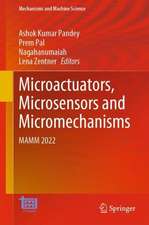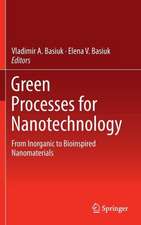Microscale Technologies for Cell Engineering
Editat de Ankur Singh, Akhilesh K. Gaharwaren Limba Engleză Hardback – 2 sep 2015
This book bridges the gap in the understanding of engineering biology at multiple length scale, including microenvironmental control, bioprocessing, and tissue engineering in the areas of cardiac, cartilage, skeletal, and vascular tissues, among others. This book also discusses unique, emerging areas of micropatterning and three-dimensional printing models of cellular engineering, and contributes to the better understanding of the role of biophysical factors in determining the cell fate. Microscale Technologies for Cell Engineering is valuable for bioengineers, biomaterial scientists, tissue engineers, clinicians, immunoengineers, immunologists and stem cell biologists, as it offers a review of the current cutting-edge cell engineering research at multiple length scale and will be valuable in developing new strategies for efficient scale-up and clinical translation.
| Toate formatele și edițiile | Preț | Express |
|---|---|---|
| Paperback (1) | 642.51 lei 43-57 zile | |
| Springer International Publishing – 23 aug 2016 | 642.51 lei 43-57 zile | |
| Hardback (1) | 654.30 lei 22-36 zile | |
| Springer International Publishing – 2 sep 2015 | 654.30 lei 22-36 zile |
Preț: 654.30 lei
Preț vechi: 769.77 lei
-15% Nou
Puncte Express: 981
Preț estimativ în valută:
125.24€ • 136.08$ • 105.27£
125.24€ • 136.08$ • 105.27£
Carte disponibilă
Livrare economică 31 martie-14 aprilie
Preluare comenzi: 021 569.72.76
Specificații
ISBN-13: 9783319207254
ISBN-10: 3319207253
Pagini: 330
Ilustrații: VIII, 330 p.
Dimensiuni: 155 x 235 x 25 mm
Greutate: 0.8 kg
Ediția:1st ed. 2016
Editura: Springer International Publishing
Colecția Springer
Locul publicării:Cham, Switzerland
ISBN-10: 3319207253
Pagini: 330
Ilustrații: VIII, 330 p.
Dimensiuni: 155 x 235 x 25 mm
Greutate: 0.8 kg
Ediția:1st ed. 2016
Editura: Springer International Publishing
Colecția Springer
Locul publicării:Cham, Switzerland
Public țintă
ResearchCuprins
From the contents : Introduction.- Part I: Microscale Technologies for Controlling Stem Cell Microenvironments.- Microscale culture of pluripotent stem cells.- Microscale technology in cellular reprogramming.- Microfluidics-based technologies for stem cells and embryos.Part II: Microscale Tissue Engineering using Stem Cells.- Spatially defined cell culture within three-dimensional hydrogels.- Combinatorial 3D Matrices for Human Embryonic Stem Cell Differentiation.- Engineered stem cell-based scaffolds and patches for heart disorders.
Textul de pe ultima copertă
This book offers readers cutting-edge research at the interface of polymer science and engineering, biomedical engineering, materials science, and biology. State-of-the-art developments in microscale technologies for cell engineering applications are covered, including technologies relevant to both pluripotent and adult stem cells, the immune system, and somatic cells of the animal and human origin.
This book bridges the gap in the understanding of engineering biology at multiple length scale, including microenvironmental control, bioprocessing, and tissue engineering in the areas of cardiac, cartilage, skeletal, and vascular tissues, among others. This book also discusses unique, emerging areas of micropatterning and three-dimensional printing models of cellular engineering, and contributes to the better understanding of the role of biophysical factors in determining the cell fate. Microscale Technologies for Cell Engineering is valuable for bioengineers, biomaterial scientists, tissue engineers, clinicians, immunoengineers, immunologists and stem cell biologists, as it offers a review of the current cutting-edge cell engineering research at multiple length scale and will be valuable in developing new strategies for efficient scale-up and clinical translation.
This book bridges the gap in the understanding of engineering biology at multiple length scale, including microenvironmental control, bioprocessing, and tissue engineering in the areas of cardiac, cartilage, skeletal, and vascular tissues, among others. This book also discusses unique, emerging areas of micropatterning and three-dimensional printing models of cellular engineering, and contributes to the better understanding of the role of biophysical factors in determining the cell fate. Microscale Technologies for Cell Engineering is valuable for bioengineers, biomaterial scientists, tissue engineers, clinicians, immunoengineers, immunologists and stem cell biologists, as it offers a review of the current cutting-edge cell engineering research at multiple length scale and will be valuable in developing new strategies for efficient scale-up and clinical translation.
Caracteristici
Covers the stem cell manufacturing in labs for fundamental studies and transformative bioengineering applications in tissue engineering Highlights the tremendous advances of microscale technologies in stem cell generation or application over the past few years Provides coverage of cardiovascular applications, high-throughput purifications, microenvironment control, and skeletal development

























